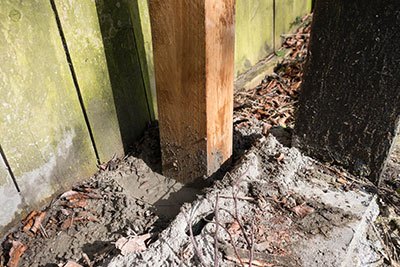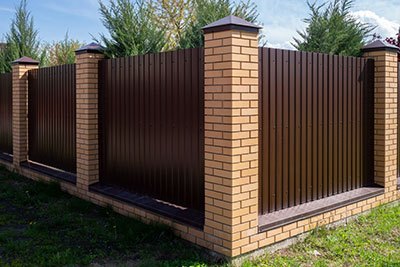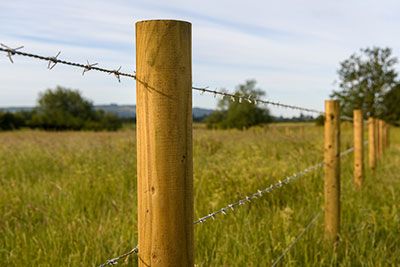Are you searching for a reliable, durable material to build a fence? If so, then this post is for you!
We’ll provide an overview of the different materials used to make fencing posts including aluminum, steel, wood, vinyl, and more. Through our extensive research, we’ve also identified top selections which will give your fence lasting performance without breaking the bank.
Read on to learn all about selecting your preferred material and take advantage of our expert advice!
Take away key points:
- Fence posts come in different materials and types, so you can choose the best one for your fencing systems
- You can install them easily or with extra help, depending on their size, shape, and type
- Some come with higher cost, some with lower cost, but you can calculate in advance to choose the best solution
Table of Contents
If you need to choose the best rural fence posts for your fencing project, you need to know their materials and composition in advance, to choose the best fencing solution.
Our guide below will help you as we cover all details of your fencing needs.
What is a fence post & what is its role?

A fence post is a sturdy vertical structure that is used to support a fence. It is usually made of wood, metal, or concrete and is anchored to the ground to provide stability to the fence.
The role of a fence post is crucial in fence installation as it supports the horizontal rails and pickets that make up the fence. Without a fence post, a fence cannot stand upright and would inevitably collapse.
Whether you’re building a new fence or replacing an old one, selecting the right fence post is essential to ensuring that your fence stands up to the elements and lasts for years to come.
What are the different types of fence posts?
There are multiple fence post types to choose from. You need to know their composition, installation, and durability factors to choose the best solution for your fences.
Let’s take a look at different fence system posts below:
1. Pine post types
Pine posts are a popular choice for building fences due to their durability and affordability. These types are available in different varieties, including end or terminal post types, line post, and corner post modes.
A terminal post adds more stability to a chain link fence. End posts mark the start and end of a fence line, while line posts are used to keep the fence panels in a straight line. Corner posts, as their name suggests, are used to support the corners of the fence.
2. Corner fence posts
Typically, corner posts are bigger and sturdier than regular fence posts since they have the crucial role of anchoring the fence line. They are positioned at 90-degree angles, allowing for more flexibility in the fence post-installation.
To form the 90-degree angle at the fence post corners, holes are drilled accordingly.
3. End fence posts
End posts have such names because they mark the end of a fence line, with holes drilled only on one side. This allows the new fence to extend from the side at which the holes have been drilled.
4. Line fence posts
The line post is utilized to link straight portions of a fence and is generally positioned at 10-foot intervals. These fencing posts feature holes on both sides. Although they work well for straight lines, with enlarged holes, the cattle fence posts can also be used for slight angles.
5. Gate posts
As the name suggests, gate posts are designed for holding gates. These posts can also be used as corner, end, or line posts, depending on the requirements of the fence.
Gate posts have two poles to hold hinges and latches and may also serve as the final post of the long-lasting fence. It is crucial to ensure that the size of the gate posts is appropriate to hold the weight of the gate.
6. Pull fence posts
A pull fence post is typically utilized in fences installed on steep slopes or staircases.
7. Pigtail posts
Pigtail posts are a suitable choice for cross-fencing in managed intensive grazing systems. They feature a lightweight, portable design and are extremely easy to use for agricultural fencing stakes. The posts have loops at their top that resemble a pig’s tail and simplify line attachment. Moreover, they do not require any clips or insulators.
Different fence post materials
Fence builders will know exactly what type of fence post is ideal for your fencing job. So, here are some of the best fence post materials available on the market.

1. Wooden fence posts
A wooden fence post is the most popular choice for residential yards due to its affordability and popularity. Wood fence posts offer a plethora of appearances, such as rounded or rectangular ends.
Wood posts can be stained or painted for both aesthetics and durability. The lifespan of the wooden fence post can also be extended by treating it.
The wood farm fence posts need regular maintenance for extra durability and strength. If you don’t maintain the regularly, the farm fence posts – wood will be prone to harm, rot, and other material or timber damage.
2. Metal fence posts
Metal fence posts, crafted from durable rail steel, provide reliable stability and security. Metal fence posts are frequently used to anchor wooden fence panels to a concrete base and are renowned for their long-lasting nature.
Moreover, metal fences are available in a range of shapes, including Y-shapes, to support different types of wire mesh. Applying anti-rust paints to them can help to diminish maintenance requirements and you can easily prolong the lifespan of the metal fence posts.
3. Aluminum fence posts
Aluminum fence posts are a perfect choice for confidentiality. They are both durable and affordable and come in a variety of colors and designs that make them stylish and appealing. Even though they cost more than wood post models, initially, they’re less expensive in the long run because they need little to no maintenance for your property.
4. Plastic fence posts
Plastic fence posts are easy to set up and do not require any maintenance and support. They are an excellent eco-friendly choice if they are made from recycled waste plastic.
5. Concrete fence posts
Strong and dense, concrete fence posts are both durable and need minimal maintenance. However, this fence post type does require additional effort for installation. Their robust construction makes them a suitable option for connecting with wood or chain link fencing.
6. T-posts
T-posts can be utilized with permanent or semi-permanent fences with a range of user-friendly accessories. They function exceptionally well as in-line posts. To be driven into the ground, T-posts require a unique handheld post-pounder.
7. Steel fence posts
Steel fence posts are an essential element when it comes to building a durable and sturdy fence. The primary purpose of steel posts is to provide stability and support to the fence, ensuring that it withstands harsh weather conditions and external pressure.
The galvanized steel fence posts are designed to hold the weight of the fence, keeping it straight and vertical, and preventing it from sagging or falling over. They are easy to install, making them an ideal choice for areas and ground where it’s challenging to dig a post hole.
FAQs
What wood was old fence posts made from?
The old models used fence post models made of spruce, pine, and larch.
Are all fence posts set in concrete?
They are made of different material types such as wood, plastic, and metal, but they are installed with cement and other adhesives.
Should I use metal or wooden fence posts?

Metal is a better option, as these units are not affected by weather and harsh elements, so they are more durable than wood units.
Why do farmers put rocks on fence posts?
They put rocks to support smooth wire.
Can you attach wood fence panels to metal posts?
Yes, you can, and the procedure is effortless.
Are fence posts always hardwood?
No, posts are not always hardwood. They can be made of fiberglass, metal, steel, wood, and other materials.
Conclusion
You must pick the best post to fit your needs and preference. There are many options, but once you know what kind of materials you need, you can choose the best option. Consider weather conditions and the longevity of each type of post.
